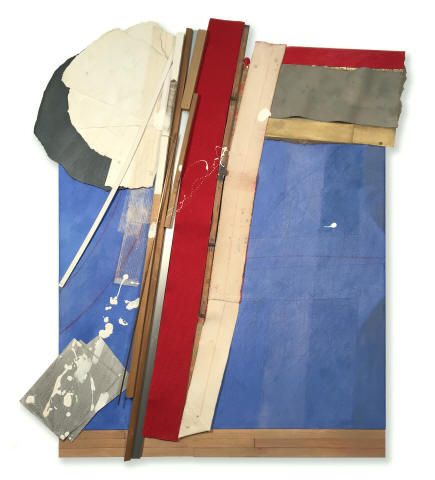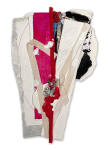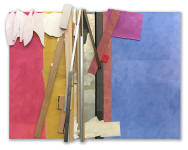Bruce Dorfman

The Placement of Ever, 2023
Canvas, metal, paper, fabric, wood, and acrylic on canvas
66 x 40 x 5 inches
|
Born New York City
Lives and works in New York City |
Education |
|
1958 |
B.A., University of
Iowa, Iowa City, IA with Mauricio Lasansky, Stuart Edie and Historian
Roy Seibere |
|
1951-52 |
The Art Students
League of New York; with Yasuo Kuniyoshi, Arnold Blanch, Charles H. Alston |
Solo Exhibitions |
|
2025 |
"…To Whom Do
We Tell…,” June Kelly Gallery, New York |
|
2022 |
Affirmations: New Works in Combined
Media, June Kelly Gallery, New
York |
|
2018-19 |
Inclusive Moments-Selected Works, 1952-2015, Gallery of the
American Fine Arts Society, The Art Students League of New York |
|
2018 |
Currents: Paintings in Combined Media,
2016-2018, June Kelly Gallery,
New York; catalogue |
|
2016 |
BRUCE DORFMAN: PRESENT PAST PRESENT,
Paintings, Drawings,
and Combined Media, DiMattio Gallery of Rechnitz
Hall, Monmouth
University, West Long Branch, NJ; retrospective, catalogue |
|
2015 |
Bruce Dorfman: Recent Work, June Kelly Gallery,
New York |
|
2013 |
The Italian
Kimono: Selected Works 2002-2013, Elizabeth V. Sullivan
Gallery, The
Art Students League of New York, Vytlacil Campus,
Sparkhill, NY |
|
2011 |
Bruce Dorfman:
Recent Work in Combined Media, Zane Bennett Gallery,
Santa Fe, NM; brochure |
|
2010 |
Mixed Media in
Small Scale, Broadhurst Gallery, Pinehurst, NC
Windsock, Kouros Gallery, New York; brochure |
|
2008 |
Propeller:
Paintings in Combined Media, Kouros Gallery, New York;
catalog |
|
2005 |
Aria, Kouros
Gallery, New York
Bruce Dorfman and the League, Kouros Gallery, New York |
|
2004 |
From Here to There,
Galerie Dionisi, West Hollywood, CA
Points, Roseline Koener Gallery, Westhampton Beach, NY |
|
2003 |
Piero’s Bell Tower, Kouros Gallery, New York; brochure |
|
2001 |
To Piero,
Roseline Koener Gallery, Westhampton Beach, NY
From Italy, The Reece Galleries, New York |
|
2000 |
Exodus, Skirball Museum, Los
Angeles, CA |
|
1999 |
Bruce Dorfman:
Assemblage-Paintings, Roseline Koener Gallery,
Westhampton Beach,
NY; catalog
Recent Work, The Reece Galleries, New York
Painting, Collage, Assemblage, J. J. Brookings Gallery, San
Francisco, CA |
|
1998 |
Bruce Dorfman,
Krisal Galerie, Geneva, Switzerland |
|
1996 |
Walter Wickiser Gallery, New
York |
|
1995 |
Stone Chime,
Korean Cultural Service, Gallery Korea, New York
Bronze Bell, The Bergen Museum of Art & Science, Teaneck, NJ |
|
1994 |
Recent Work, Hal Katzen Gallery,
New York
Recent Collages, Addison/Ripley Gallery, Washington, DC |
|
1993 |
Bruce Dorfman, Art Center of
Northern New Jersey, New Milford, NJ |
|
1992 |
Bruce Dorfman, New School for Social
Research, New York |
|
1990 |
Paintings and
Collages, 1989-1990, Susan Schreiber
Gallery, New York
Addison/Ripley Gallery, Washington, DC |
|
1988 |
Nightsongs and
Placefields, Arras Gallery, New
York |
|
1986 |
Placefields, Arras Gallery, New
York |
|
1982 |
Recent Work,
Arras Gallery, New York |
|
1981 |
The Plumfields
Paintings, New School for Social Research, New York |
|
1978 |
Hillsides, Nobe Gallery, New
York |
|
1977 |
Bruce Dorfman, Barret House Gallery,
Poughkeepsie, NY |
|
1976 |
Recent Work, Nassau Community
College, Firehouse Gallery, Garden
City, NY |
|
1975 |
Bruce Dorfman, Images Gallery,
Toledo, Ohio |
|
1972 |
Women, Kennedy Galleries,
New York |
|
1971 |
Gallery Jose Alegria,
San Juan, Puerto Rico |
|
1969 |
K Gallery, Woodstock, NY |
|
1967 |
Female Images,
Krasner Gallery, New York
Marist College, Poughkeepsie, NY |
|
1966 |
Polari Gallery,
Woodstock, NY
Roberts Gallery, Fort Lauderdale, FL |
|
1964 |
Rudolph Galleries,
Woodstock, NY and Coral Gables, FL |
|
1962 |
Bruce Dorfman,
The Norton Museum, West Palm Beach, FL
Roger Price Gallery, New York |
|
1960 |
Two Explorers
Gallery, New York |
|
1955 |
University of Iowa,
Iowa City, IA |
Selected Group Exhibitions |
|
2022-2023 |
Tensile Strength, works from the
Kemper Museum Permanent
Collection inclusive of Bruce Dorfman,
Kemper Museum of
Contemporary Art, Kansas City, MO |
|
2022 |
Arriving at Byrdcliffe, Bruce Dorfman,
Philip Guston, Bob Dylan,
Herman Cherry, and Milton Avery,
Exhibition curators: Bruce Weber-
Art Historian; Gallerist; Museum
Curator. Henry T. Ford-Woodstock
Historian, Director Emeritus of
Byrdcliffe Guild.
Director of Exhibitions, Ursula Morgan, The Kleinert/James Center for
the Arts, Woodstock, NY |
|
2018 |
The Masters: Art Students League
Teachers and Their Students, Hirschl
Adler Gallery, New
York; 511 Projects in Chelsea, New York;
Phyllis
Harriman Mason Gallery, The Art Students League of New York
Artistic Vanguard: The 1960s and the Art Students League
coinciding
with Carnegie Hall’s Music Festival The 60s: The Years
that Changed
America, Phyllis Harriman Mason Gallery, The Art Students League of
New York |
|
2017 |
Celebrating 30 Years, Gallery Artists:
Drawings and Photographs, June
Kelly Gallery, New York |
|
2016 |
Ways and Means: A New Look at Process
and Materials in Art, curated by
Jason Andrew of Norte Maar, 1285 Avenue of the Americas Art
Gallery, New York
Art New York, NYC; Elizabeth Clement Fine Art, Boston, MA
Art Miami/Wynwood, Miami, FL - Elizabeth Clement Fine Art,
Boston,
MA |
|
2015 |
Escola International de Arte Loule:
1993-1998, Museum of Art and
Cloisters, Loule, Portugal
Eye on UI: Bruce Dorfman, Stan Brodsky, Robert Kipness, Ellen Lanyon,
in
conjunction with the University of Iowa Museum of Art, The Figge
Museum, Davenport, IA |
|
2014 |
Making/Breaking
Traditions: Teachers of Ai Weiwei: Bruce Dorfman,
Richard Pousette-Dart,
Knox Martin, (with lineage mentors:
Yasuo
Kuniyoshi, Vaclav Vytlacil and Will Barnett); Phyllis Harriman
Mason Gallery, The Art
Students League of New York |
|
2012 |
17 - Annual Selected
Group, Zane Bennett Gallery, Santa Fe, New
Mexico
Annual Selected Group, Zane Bennett Gallery Santa Fe, NM |
|
2011 |
Seeing Blue,
University of Kentucky Museum of Art, Lexington
Color Speaks, Heather James Gallery, Jackson, WY
Color Speaks, Heather James Gallery, Palm Desert, CA. |
|
2008 |
Summer Color,
R. H. Ballard Gallery, Washington, VA |
|
2007 |
Object of One’s
Collection, organized by Broadhurst Gallery, Pinehurst,
NC,
Fayetteville Museum of Art, NC |
|
2006-08 |
Highlights From
the Permanent Collection, The Art Students League of
New York; traveling exhibition |
|
2006 |
Works on Paper,
Kouros Gallery, New York |
|
2004 |
Small Works II:
Love, Salander-O’Reilly Galleries, New York, New York |
|
2003 |
Process,
Harvey Dinnerstein, Bruce Dorfman, Lorrie Goulet, organized
and curated
by Pamela N. Koob, The Art Students League of New
York; catalogue |
|
2002 |
Looking Forward,
Kouros Gallery, New York
Small Works, Salander-O’Reilly Galleries, New York
Roseline Koener Gallery, Westhampton Beach, NY |
|
2001 |
The Reece Galleries,
New York |
|
2000 |
Woodstock School of
Art, Woodstock, NY
Intermission III, The Reece Galleries, New York
Skirball Museum, Skirball Cultural Center, Los Angeles, CA
Terrain, Roseline Koener Gallery, Westhampton Beach, NY |
|
1999-00 |
Intermission II,
The Reece Galleries, New York |
|
1999 |
Artists/Mentors,
Denise Bibro Fine Art, New York
5, Bruce Dorfman, Judith Dolnick, Robert Natkin, Joel Perlman,
Larry
Poons, curated and organized by Jason, Andrew, Axis Gallery, NY;
catalogue |
Selected Public and Corporate Collections |
|
Albright-Knox Art Gallery,
Buffalo, NY
Butler Institute of American Art, Youngstown, OH
Carnegie Museum, Pittsburgh, PA
Harn Museum of Art , University of Florida, Gainesville, FL
McNay Museum, San Antonio, TX
Museum of Art, University of Kentucky, Lexington
Smithsonian American Art Museum, Washington, DC
The Bergen Museum of Art and Science, Paramus, NJ
The Everson Museum, Syracuse, NY
Syracuse University, Syracuse, NY
The Skirball Museum, Los Angeles, CA
Rice University, Sewall Gallery, Houston, TX
University of Kansas, Lawrence, KS
Marist College, Poughkeepsie, NY
Rockefeller Foundation, New York
Woodstock Artists Association Museum, Woodstock, NY
The Art Students League of New York
The New School for Social Research, New York
The Museum of Loulé, Portugal
Collection Mourlot, Paris, France
Atlantic Richfield Corporation, Los Angeles, CA
Baer Bank, Geneva, Switzerland
Commerce Trust Company Foundation, Kansas City, MO
The Cook Company Foundation, Chicago, IL
Dart-Kraft Corporation, Chicago, IL
Searle Corporation, Chicago, IL
The Faber-Castell Corporation, Lakewood, NJ
American Embassy, Santo Domingo, Dominican Republic
Government of Israel, Tel Aviv, Israel
Government of Monaco, Permanent Mission to the United Nations, New York |
|
Click
on thumbnail for larger image. |
|

|
|

|
|
![]()